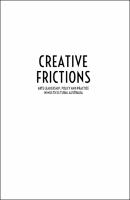Creative Frictions
Arts Leadership, Policy and Practice in Multicultural Australia
| dc.contributor.author | Cmielewski, Cecelia | |
| dc.date.accessioned | 2021-10-06T11:52:35Z | |
| dc.date.available | 2021-10-06T11:52:35Z | |
| dc.date.issued | 2021 | |
| dc.identifier | ONIX_20211006_9781760464592_4 | |
| dc.identifier | OCN: 1262785069 | |
| dc.identifier.uri | https://library.oapen.org/handle/20.500.12657/50772 | |
| dc.description.abstract | Creative Frictions explores the relationship between visionary aspects of practice and policy. Despite over 30 years of arts and cultural policy attention, there remains a widespread view among the general public and artists alike that creative production does not reflect Australia's culturally diverse population. Australia’s increasingly complex society can no longer be confined to 'essentialised’ or traditional definitions of ethnic communities. While this diversity and its emerging complexity can be ‘celebrated’ as a source of creativity and innovation, it can also give rise to social, political and creative challenges. A key challenge that remains for the arts sector is its ability to support the creative expression of cultural difference. One measure of inclusive creative production is to look at the participation of artists of non–English speaking backgrounds (NESBs)—a problematic term discussed in the book. There are half as many NESB artists compared to those of other professions participating in the workforce, and while under-representation is an issue for management in the arts sector, the question of representation also benefits from being understood more broadly beyond the narrow sense of multiculturalism as a tool to manage cultural difference. This book explores the crucial role of creative leaders and how they work with the ‘mainstream’ while maintaining their creative integrity and independence to generate a ‘virtuous’ circle of change. Creative Frictions argues that it is the NESB artists who lead change in the arts sector and that creative and organisational leadership working in partnership make creative use of ‘friction’ and develop the necessary ‘trust’ to generate the ‘traction’ for a supportive multicultural arts milieu. | |
| dc.language | English | |
| dc.subject.classification | thema EDItEUR::A The Arts::AB The arts: general topics | en_US |
| dc.subject.classification | thema EDItEUR::J Society and Social Sciences::JB Society and culture: general::JBC Cultural and media studies::JBCC Cultural studies | en_US |
| dc.subject.classification | thema EDItEUR::J Society and Social Sciences::JB Society and culture: general::JBS Social groups, communities and identities::JBSL Ethnic studies::JBSL1 Ethnic groups and multicultural studies | en_US |
| dc.subject.classification | thema EDItEUR::J Society and Social Sciences::JP Politics and government::JPP Public administration | en_US |
| dc.subject.other | multicultural | |
| dc.subject.other | arts policy | |
| dc.subject.other | NESB artists | |
| dc.subject.other | diversity | |
| dc.subject.other | representation | |
| dc.title | Creative Frictions | |
| dc.title.alternative | Arts Leadership, Policy and Practice in Multicultural Australia | |
| dc.type | book | |
| oapen.identifier.doi | 10.22459/CF.2021 | |
| oapen.relation.isPublishedBy | ddc8cc3f-dd57-40ef-b8d5-06f839686b71 | |
| oapen.relation.isbn | 9781760464592 | |
| oapen.imprint | ANU Press | |
| oapen.pages | 304 | |
| oapen.place.publication | Canberra |

